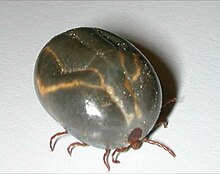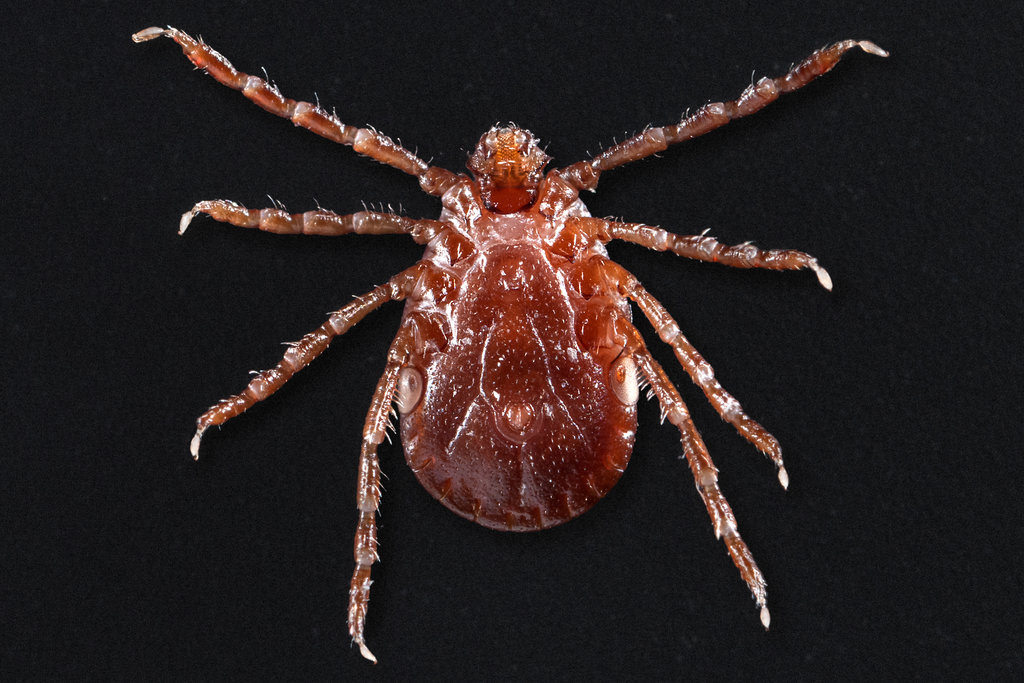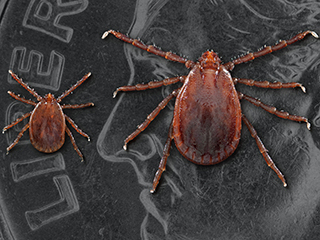Map Snapshot


3 Records
Status
Unfortunately this invasive species has been detected on White-tailed Deer in Washington County, Maryland. It is currently known to occur in at least nine states (as of 8/2018) and is a known disease vector. (Maryland DNR, pers. comm.) Native to temperate areas of eastern and central Asia. Apparently only detected on mainland U.S. as recently as November 2017.
Relationships
Parasite of birds and mammals, including cattle, dogs, cats, and humans. Human pathogens have not yet been detected in the U.S., but it is associated with a long list of diseases elsewhere in its known range.
Seasonality Snapshot
Source: Wikipedia
| Haemaphysalis longicornis | |
|---|---|

| |
| Illustration by Des Helmore | |
| Scientific classification | |
| Domain: | Eukaryota |
| Kingdom: | Animalia |
| Phylum: | Arthropoda |
| Subphylum: | Chelicerata |
| Class: | Arachnida |
| Order: | Ixodida |
| Family: | Ixodidae |
| Genus: | Haemaphysalis |
| Species: | H. longicornis
|
| Binomial name | |
| Haemaphysalis longicornis Neumann, 1901
| |
Haemaphysalis longicornis, the Asian longhorned tick,[1] longhorned tick,[2] bush tick,[2] Asian tick,[3] or cattle tick, is a parasitic arachnid belonging to the tick family Ixodidae. The Asian longhorned tick is a known livestock pest, especially in New Zealand, and can transmit a disease called theileriosis to cattle but not to humans. However, the tick has been associated with several other tickborne diseases in humans.

An unfed female is typically 2.0–2.6 mm long and 1.5–1.8 mm wide, and grows to 9.8 mm long and 8.2 mm wide with engorgement.[5] Distinguishing a specimen from other members of the genus Haemaphysalis requires microscopic examination of minor physical characteristics.[6]
Geographic distribution
[edit]The Asian longhorned tick is native to temperate areas of East and Central Asia, including China, Korea, and Japan, as well as Pacific islands including Australia, New Zealand, Fiji, and Hawaii, to name a few.[7]
The species was not known to be present on the mainland United States until 9 November 2017, when it was first discovered on a sheep farm in Hunterdon County, New Jersey, although it had been intercepted at U.S. ports on import animals and materials at least a dozen times.[2] The Asian longhorned tick has been found in eleven states, including New Jersey, Virginia, West Virginia, North Carolina, South Carolina, Pennsylvania, New York, Arkansas, Maryland, Connecticut, and Ohio.[8][9][10][11] Attempts to eradicate the species from New Jersey failed; the tick successfully overwintered and has since become established in the state as an invasive species.[12][13][14] The tick may have been present in the eastern US for several years, but only recently detected.[10]
Biology
[edit]
The seasonal feeding and reproductive cycle resembles that of other ticks. The tick can reproduce sexually or by an asexual process called parthenogenesis. The latter exist in northern Japan and Russia, whereas the former exist in southern Japan, southern Korea and southern parts of the former Soviet Union. An aneuploid race capable of both sexual and asexual reproduction capability exists in China. Unfed ticks can survive for close to a year, nymphs and adult females the longest, depending on temperature and humidity.[7]: 6–7
Host
[edit]The Asian longhorned tick parasitizes mammals and birds. It spreads quickly in farm animals such as cattle, horses, sheep, pigs, and chickens. Natural infestations have been found on wild animals like bear, deer, foxes and hares, small mammals like ferrets and rats, and birds. It has also been found on cats, dogs, and humans. It is believed to migrate by parasitizing birds, which carry it to new areas.[7]: 4
Disease vector
[edit]The Asian longhorned tick can transmit an animal disease called theileriosis to cattle, which can cause considerable blood loss and occasional death of calves, but mainly is important to dairy farmers because of decreased milk production and sheep farmers because of decreased wool quantity and quality.[7]: 4–5
Human diseases such as Lyme spirochetes, spotted fever group rickettsiae,[15] Ehrlichia chaffeensis, and Anaplasma bovis have been detected in H. longicornis.[16] It has been associated with Russian spring-summer encephalitis, Powassan virus, Khasan virus, tick-borne encephalitis virus,[7]: 4 Japanese spotted fever,[17] and severe fever with thrombocytopenia syndrome.[12] Human pathogens have not so far been detected in the Asian longhorned tick in the US.[10]
See also
[edit]References
[edit]- ^ "US invaded by savage tick that sucks animals dry, spawns without mating". Ars Technica. 8 August 2018.
- ^ a b c "Exotic Tick Species Identified on Hunterdon County Farm". Department of Agriculture, State of New Jersey. 21 November 2017. Retrieved 2 December 2017.
- ^ "Native to Asia, Found in New Jersey: The Curious Case of an Invasive Tick". Entomology Today. 21 February 2018. Retrieved 2 August 2018.
- ^ James Gathany. "Haemaphysalis longicornis". Centers for Disease Control and Prevention Public Health Image Library (PHIL).
- ^ "Longhorned Tick a.k.a. Cattle Tick or Bush Tick (Haemaphysalis longicornis)". Northeast Regional Center for Excellence in Vector-Borne Diseases. Retrieved 8 August 2018.
- ^ Burtis, James; et al. "Intruder Alert: Longhorned Tick" (PDF). U.S. DOD Under Secretary of Defense for Acquisition, Technology, and Logistics. Retrieved 8 August 2018.
- ^ a b c d e Rachel Cane Haemaphysalis longicornis Neumann, 1901 Profile New Zealand Biosecure Entomology Laboratory, April 2010, 9pp.
- ^ "First Confirmed Longhorned Tick Found in Maryland". Maryland Department of Natural Resources. 7 August 2018. Retrieved 7 August 2018.
- ^ "PRO/AH/EDR> Invasive tick – USA (09): (NY)". promedmail.org. Retrieved 30 July 2018.
- ^ a b c "Invasive tick – USA (11): (PA)". promedmail.org. Retrieved 2 August 2018.
- ^ Beard, C. Ben; Occi, James; Bonilla, Denise L.; Egizi, Andrea M.; Fonseca, Dina M.; Mertins, James W.; Backenson, Bryon P.; Bajwa, Waheed I.; Barbarin, Alexis M.; Bertone, Matthew A.; Brown, Justin (30 November 2018). "Multistate Infestation with the Exotic Disease–Vector Tick Haemaphysalis longicornis – United States, August 2017–September 2018". Morbidity and Mortality Weekly Report. 67 (47): 1310–1313. doi:10.15585/mmwr.mm6747a3. ISSN 0149-2195. PMC 6276380. PMID 30496158.
- ^ a b Lee, Bruce Y. (21 April 2018). "New Jersey Is Dealing with a Tick Species That Is New to America". Forbes. Retrieved 22 April 2018.
- ^ "A swarming, exotic tick species is now living year round in N.J." 21 April 2018. Retrieved 22 April 2018.
- ^ Taylor, Dan (21 April 2018). "Shocking discovery in New Jersey, authorities scrambling". Morning Ticker. Retrieved 22 April 2018.
- ^ Meng Z.; Jiang L. P.; Lu Q. Y.; Cheng S. Y.; Ye J. L.; Zhan L. (December 2008). "[Detection of co-infection with Lyme spirochetes and spotted fever group rickettsiae in a group of Haemaphysalis longicornis]". Zhonghua Liu Xing Bing Xue Za Zhi (in Chinese). 29 (12): 1217–1220. PMID 19173967.
- ^ Mi-Jin Lee; Joon-Seok Chae (2010). "Molecular detection of Ehrlichia chaffeensis and Anaplasma bovis in the salivary glands from Haemaphysalis longicornis ticks". Vector-Borne and Zoonotic Diseases. 10 (4): 411–413. doi:10.1089/vbz.2008.0215. PMID 19874189.
- ^ "PRO/AH/EDR> Invasive tick – USA: (NJ)". promedmail.org. Retrieved 30 July 2018.
External links
[edit]- Species Profile – Asian Longhorned Tick (Haemaphysalis longicornis), National Invasive Species Information Center, United States National Agricultural Library.



